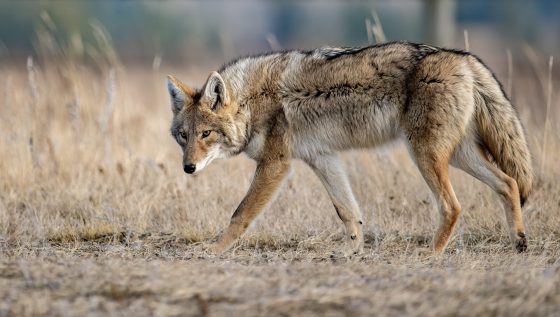You may be wondering if coyotes will attack cats. If you live in an area with coyotes, you need to know their habits. Can cats run away from them? And is it normal for cats to be scared of coyotes? Read on to learn more about coyotes and cats. You might be surprised at how much they fear them. But they are not necessarily dangerous. Here are some tips for cat owners to protect their beloved pets.

Will coyotes attack cats?
Coyotes do not usually attack cats, but they may if they think that they are a tasty treat. Despite their name, coyotes only need four pounds of food each day. In addition, they’re opportunistic hunters and may be tempted to gorge on your cat, especially if it has young kittens. However, once they’ve finished eating your cat, coyotes will not be hungry again for a while.
While cats are not generally considered to be a threat, coyotes will attack your cat if it is close to their den or territory. In general, these animals can be caught, sterilized, and released, but this can be risky. Cats that are left unattended could become a breakfast item for hungry coyotes. Some cat owners worry that coyotes carry diseases. Coyotes may be carriers of rabies, which can be transmitted to humans. So, if you want to avoid the risk of a coyote attacking your cat, be sure that your cat is current on its rabies vaccination.
If coyotes feel threatened by cats, they may adapt their habits to hunt them. Because they’re opportunistic and prefer carrion and trash over fresh meat, they will feast on your cat’s remains. If your cat is too small to be eaten, you should make sure that you have a safe place for your cat to hide. That way, it’s not as likely to get attacked.
Because coyotes are nocturnal animals, their feeding schedules can cause them to come into your home. Make sure you remove any food sources where they can access them. If possible, you can also get rid of the food sources and prevent your cat from being a victim of a coyote attack. If you want to keep your cat safe and protected, make sure it has a cozy wooden shelter and a safe place to escape.
Can a cat run away from a coyote?
Cats are often afraid of predators and may attempt to hide in places where they can’t be seen. This can be dangerous for several reasons. For starters, they may be elderly or infirm, and they may have problems with their agility. Another factor in avoiding an encounter with a coyote is whether your cat is overweight or carries an infectious disease. In addition, cats are natural hunters, and if you leave your cat outside unsupervised at night, it could become prey for a coyote. Additionally, you should never feed your cat in a corner, as it may get cut off by the coyote.
While some cats can get away from a coyote attack, they rarely survive the encounter. A dog may be more likely to survive a coyote attack, and a large dog can even be killed by a coyote. A coyote’s main diet during the winter months in California is domestic animals, so if you leave food out for feral cats, you may risk an attack.
The American Bird Conservancy estimates that free-roaming cats kill about 100 million birds each year. While coyotes aren’t aggressive toward humans, they do pose a significant threat to pets and cat owners. While they rarely attack humans, they do bite humans and sometimes pets. A recent study in the Journal of Wildlife Management attached collars to eight wild coyotes for 4 months. The animals encountered cats 36 times, and 19 of them were fatal.
Coyotes have powerful legs. They can reach speeds of 40 mph and kill prey with ease. Therefore, they are dangerous for cats, and they should always be kept in an enclosed area. But if you do allow your cat to roam freely, it is unlikely to become a victim. If your cat is old, you must take precautions to protect them from coyotes.
Is it common for coyotes to attack cats?
Coyotes are predatory animals and are known to attack domestic cats. Their prey consists of small mammals, birds, reptiles, and fish. Because they are fast and jump high, these animals are dangerous to small pets and are at risk for poisoning. A cat that is left outside alone at night may also become prey to coyotes, resulting in an attack.
One of the easiest ways to protect your cat from coyotes is to bring your cat inside. Coyotes can’t outrun a cat, but they are powerful enough to kill it. In addition to that, they’re nocturnal, which means they’re more likely to attack cats between 10:00 PM and 5:00 AM. During their breeding season (mid-spring to early summer), coyotes may target your cat if there is a supply of food available.
A coyote’s behavior in the wild depends on its diet. These omnivorous creatures typically eat small mammals and herbivores, although they also eat reptiles and amphibians. Coyotes have been known to spook small dogs, but cats are their prime prey. However, the number of attacks on domestic pets and cats is not known.
In many cases, coyotes kill both cats and humans. They are often grouped under “household pets,” but the reality is that cats are prey for feral cats, so removing the animals from their homes is more effective than general population reduction. In some cases, coyotes may even switch over to livestock to survive in difficult circumstances. The American Bird Conservancy estimates that free-roaming cats kill about 100 million birds annually. Even so, many cat owners do not want to lock their felines in the house for fear of coyotes.
Are cats afraid of coyotes?
Do coyotes fear cats? No, but the thought of their vicious teeth makes many cat owners tremble. While they are generally less aggressive than feral cats, house cats are at a greater risk of attacks from coyotes when they are allowed outside. If you live in an area where coyotes are common, take precautions to protect your cat from them. Here are some tips.
First, let’s talk about coyote behavior. Most coyote attacks happen between 10 p.m. and 5 a.m. That’s when the predators are most active and need more food than in any other month. Furthermore, female coyotes are fiercely protective of their territory, so if your cat is outside at that time, you should keep it indoors. Coyotes prefer flat, short areas. Keep your lawn short and weed-free, or you could be inviting a coyote attack.
The best way to keep a coyote away from your yard is to get rid of any food sources they may find around your yard. Coyotes often come into homes for food and will feast on bird feeders, trash, and garden waste. So, if you’re unsure whether coyotes are a threat to your cat, consider removing these areas from your yard.
Although coyotes are not typically known to attack humans, they are known to attack pets in their territory. While coyotes will generally only attack small dogs and cats, they can also kill rabbits, mice, and even cats. If you do encounter a coyote, keep your distance. A coyote will hardly ever attack your cat, but they might attack your cat if you try to pet it.
Are Possums and Coyotes Equally Dangerous to Cats?
When considering possums and cats potential risks, it’s vital to assess their individual characteristics. While coyotes are known predators, possums generally pose a minimal threat to cats. However, territorial conflicts may arise between a cat and a possum, potentially leading to minor altercations. Nevertheless, it is wise to supervise and ensure the safety of cats in areas where both creatures coexist.
Do cats know to avoid coyotes?
Coyotes are nocturnal predators that have become increasingly common in our urbanized areas. Unfortunately, there is no nationwide database tracking coyote attacks on domestic cats. Despite this, if you are outside with your cat, try to keep it indoors at night and during the pup-rearing season. Here are some tips for preventing coyote attacks on your cats.
First, don’t assume coyotes will kill your cat on sight. Coyotes are extremely smart animals and can observe your routine for days. If they see your cat, they’ll most likely try to grab it. They have been observed snapping the necks of cats and small dogs. It’s hard to avoid coyotes, but it’s important to remember that coyotes have been known to attack domestic pets in the past.
Cats are extremely good at identifying a coyote’s presence, which is why you should keep the fence at least five feet high. Coyotes can easily jump over fences, so they need a good escape route. Also, don’t feed your cat in a corner. If a coyote is nearby, it can cut off the corner, and your cat will have nowhere to go.
It’s best to keep your cat indoors when possible. Coyotes don’t prefer to kill pets and will strike first if they feel that they’re easy prey. Fortunately, there are a variety of ways to keep your cat safe from these predators. If your cat is allowed to roam outdoors, you can protect him from coyotes by securing your trashcans and fencing.










